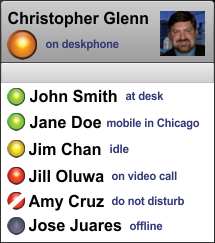Presence information
In electronic telecommunications, presence information is information that contains the possibility and readiness of a potential communication partner (for example another user for a conversation). The client of a user touted its status to a presence server that manages this and more widespread if necessary.
Presence information is an important component and the most important innovation driver in today's instant messaging and VoIP services.
Presence status
The client of a user can publish a presence status in order to publish the current communication status of the user. This status publication informs others who communicate with the user about his availability and willingness to communicate. Nowadays the presence status is most often displayed as a small icon in instant messenger clients, usually different icons for different statuses.
The dial tone in combination with the busy tone in the classic telephone network is actually a presence status, even if it is not mentioned in this context.
Common status variants that can be found in almost every instant messaging client are “Available for chat”, “Present”, “Away”, “Busy”, “Do not disturb”. In addition, additional attributes such as mood, location or free text fields are also available in some instant messenger clients.
privacy
Presence information is extremely sensitive and in real systems it would be appropriate to limit the presence information to a closed group of users. Outside of working hours, for example, it is interesting for employees not to inform their colleagues about everything. A minimal version of this is already implemented in many instant messaging programs and is expressed in the "invisible" status, which is only visible to certain selected contacts.
literature
- M. Day, J. Rosenberg, H. Sugano: A Model for Presence and Instant Messaging. RFC 2778 . February 2000.
- Open Mobile Alliance OMA Instant Message and Presence Service V1.1 Approved Enabler ( Memento from September 29, 2007 in the Internet Archive ) November 2002.
- Open Mobile Alliance OMA Presence Simple V1.0 Approved Enabler ( Memento from September 29, 2007 in the Internet Archive ) July 2006.
- 3GPP TR 23.841 (Technical Report) Presence service; Architecture and Functional Description
- 3GPP TS 23.141 (Technical Specification) Presence service; Architecture and functional description; Stage 2
- 3GPP TS 24.141 (Technical Specification) Presence service using the IP Multimedia (IM) Core Network (CN) subsystem; Stage 3

